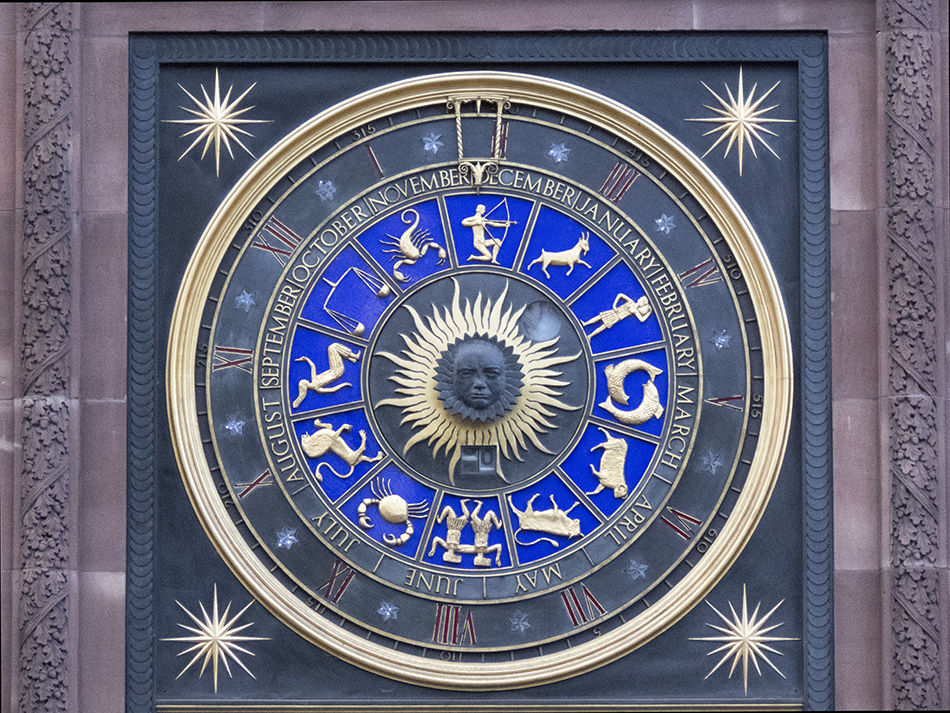
Although time and its measurement is a fundamental component of human life, a special type of clock which takes matters to the next level is the so-called
astronomical clock and whose purpose is not to measure time per se but to convey astronomical information and, in particular, the relative position of the
Sun and Moon as well as the zodiacal constellations and, in some cases, the position of the planets all as a function of time.
The oldest such effort to effectively emulate the overhead celestial sphere (ie a mini-planetarium) is the
Antikythera Mechanism which was discovered in 1901 totally by
accident by sponge divers off the coast of the Greek island of Antikythera. It has been dated to approximately 80 BC and it is believed to be the work of
Poseidonius of Rhodes. The Antikythera Mechanism is currently on display
at the National Archaeological Museum in Athens, Greece.
Note: Lying less than 200 meters from St Paul's Cathedral in central London, Bracken House is characterized with the stunning
astronomical clock seen below and which graces its main entrance. The building was built in the 1950's on a site bombed during WWII and originally housed the
Financial Times newspaper and uptly named after the newspaper's founder, namely Brendan Bracken. Following various changes in occupancy, the Financial Times
returned once again to Bracken House in 2019 for its operations. In 1987, the building was listed as part of English Heritage due to its historical significance
and is now protected by law against any destruction or alteration to its historical character.
The astronomical clock below is characterized with a diameter of approximately one meter and was constructed in 1959 by the firm Thwaites & Reed who have been
making clocks since their establishment in 1740. The clock is quite unique, for it does not employ hands to indicate date or time but uses rotating dials
which describe the month, time (hour and minutes) as well as the seasonal constellations by placing the corresponding dial's information at the 12 o'clock
position. More specifically, the outermost ring describes the minutes of the current hour using the Arabic numerals 05 to 60 but with demarcations for each
minute. The following ring is engraved with the Roman numerals I through XII, thus denoting the hour of day (12-hr format) with mid-hour denoted by six-sided
stars. The next ring immediately denotes the months of the year in capital letters with the current month also placed at the 12 o'clock position (November in
the image below). Gold-plated signs of the zodiac set against a blue enamel background form the following innermost ring. A circle to the upper right of the
central caricature is used to denote the current phase of the moon with the help of a moving terminator across the circle. The day of the month is displayed
immediately below the central caricature and which is "30" for this visit (see link for the zoomed-in version using greater focal length provided below).
At the center of the clock is a depiction of the Sun with a figure of Winston Churchill, personal friend of Brendan Bracken, superimposed upon it.
The clock is backlit at night and which makes for a totally different view of this majestic clock between day and night (click
here for the nighttime view).
Note: For a view of the astronomical clock using different focal lengths, please click
here and
here.
Note: For additional results involving astronomical clocks from around the world, please click
here.
|
Body: Sun Mass: 332,900 x Earth Mass Eq Diameter: 109.1 x Earth Distance: 149 million km RA / Dec: 23h 41m 41s / +89° 19' 51" Diameter: 32.16' Magnitude: -26.8 |
 |
Date: Nov 30, 2023 Location: Bracken House, London, England Equipment: Canon PowerShot SX60 HS @ 44.59 mm / f5.6 Exposure: 1 x 1/160 sec ISO 1250 JPG Fine Image Format 4768x3516 Image Size Custom White Balance Continuous Servo Mode Manual Mode Software: Photoshop CS6 Processing: White Balance Adjustment Resampling JPG Compression |